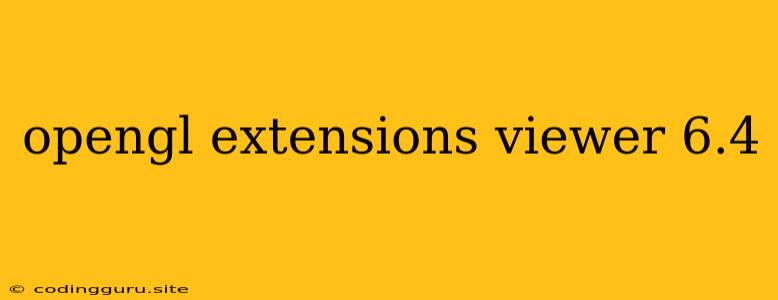Unlocking the Power of OpenGL: Exploring Extensions with the OpenGL Extensions Viewer
As you dive deeper into the world of OpenGL, you'll encounter the term "extensions." These extensions are crucial for accessing cutting-edge graphics capabilities and features beyond the core OpenGL specification. They allow you to push the boundaries of your applications, enhancing performance, visuals, and functionality.
But navigating the world of OpenGL extensions can be daunting. You might find yourself asking:
- What are OpenGL extensions, and why do they matter?
- How can I find out what extensions my system supports?
- How do I use these extensions in my OpenGL projects?
The OpenGL Extensions Viewer is a powerful tool that addresses these questions and empowers you to unlock the full potential of your OpenGL applications.
What is the OpenGL Extensions Viewer?
The OpenGL Extensions Viewer is a free, open-source tool designed to help developers understand and utilize OpenGL extensions. It acts as a comprehensive guide to the extensions available on your system, providing detailed information about their capabilities and requirements.
Why Use the OpenGL Extensions Viewer?
Here's why the OpenGL Extensions Viewer is an indispensable tool for any serious OpenGL developer:
- Extension Discovery: The viewer provides a comprehensive list of all the extensions supported by your graphics driver. You can quickly identify the specific extensions available on your system and explore their functionalities.
- Technical Details: The viewer offers in-depth information about each extension, including its version, vendor, functionality, and related functions. This detailed documentation helps you understand the extension's capabilities and limitations.
- Compatibility Check: The viewer can help you ensure that your code is compatible with the extensions supported by your target hardware. It can alert you to potential compatibility issues and guide you toward alternative approaches.
- Code Generation: The viewer can generate code snippets for specific extensions, making it easier to integrate them into your projects.
- Version Control: The viewer allows you to compare the supported extensions across different OpenGL versions. This is essential for maintaining code compatibility and understanding how extensions have evolved over time.
Getting Started with the OpenGL Extensions Viewer
The OpenGL Extensions Viewer is available for both Windows and Linux platforms. You can download and install it from [insert a relevant source, such as the official website or a well-known download repository].
Once installed, simply launch the OpenGL Extensions Viewer and it will automatically scan your system for available extensions. The viewer will present a clear and organized list of the extensions supported by your graphics driver.
Exploring the Interface
The OpenGL Extensions Viewer offers a user-friendly interface for navigating the vast world of OpenGL extensions. You can explore extensions based on:
- Category: The viewer categorizes extensions based on their functionalities, like rendering, textures, shaders, or advanced features.
- Vendor: You can filter the extensions by the specific vendor (e.g., NVIDIA, AMD, Intel) that created them.
- Version: The viewer allows you to see which extensions are supported by different OpenGL versions.
For each extension, the viewer provides detailed information, including:
- Extension Name: The unique identifier of the extension.
- Version: The OpenGL version that introduced the extension.
- Vendor: The graphics vendor that implemented the extension.
- Function List: A complete list of the functions provided by the extension.
- Description: A brief description of the extension's purpose and capabilities.
- Dependencies: Any prerequisite extensions or OpenGL versions required to use the extension.
Putting Extensions into Practice
Once you've identified the extensions relevant to your project, the OpenGL Extensions Viewer can help you integrate them into your code. The viewer provides code examples and snippets demonstrating how to use specific extensions within your application.
Here's a basic example of using an extension in your OpenGL code:
#ifdef GL_EXT_texture_compression_s3tc
// Code that uses the GL_EXT_texture_compression_s3tc extension
#endif
This snippet shows how you can use the #ifdef preprocessor directive to conditionally compile code that utilizes a specific extension, ensuring compatibility across different systems.
Tips for Effective Extension Use
- Prioritize: Focus on the extensions that offer the greatest benefit for your project. Avoid overloading your code with unnecessary extensions.
- Compatibility: Always check the compatibility of extensions with your target hardware and OpenGL version.
- Testing: Thoroughly test your application with various extensions and graphics drivers to ensure stability and performance.
- Documentation: Keep your code well-documented to explain the purpose and usage of each extension.
Conclusion
The OpenGL Extensions Viewer is a valuable resource for any OpenGL developer who wants to unlock the full potential of their applications. By providing a comprehensive overview of available extensions, detailed technical information, and helpful code examples, the viewer empowers you to leverage the power of extensions to create visually stunning and feature-rich applications.
